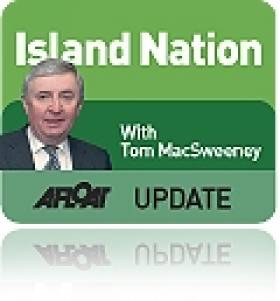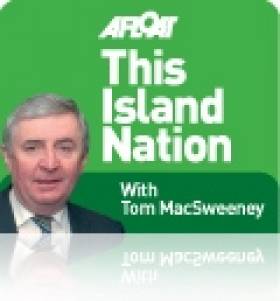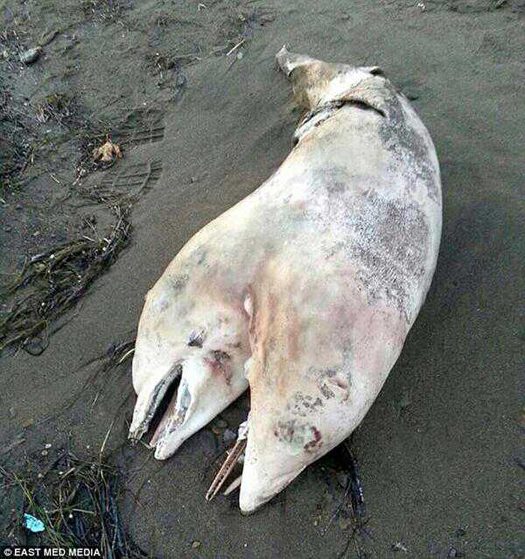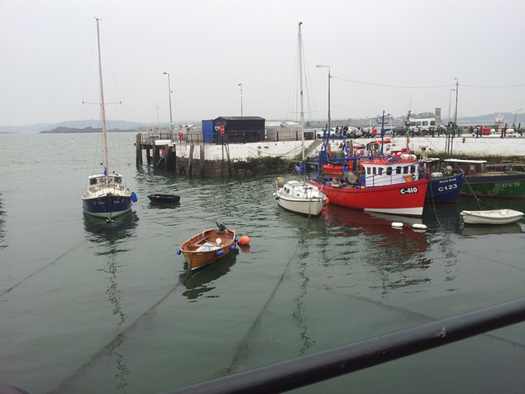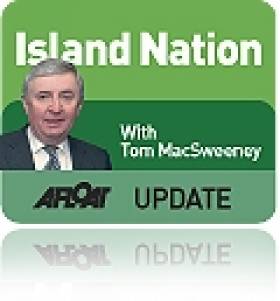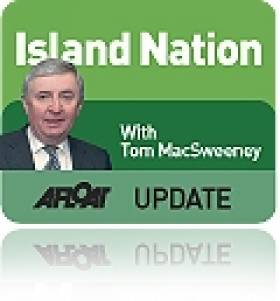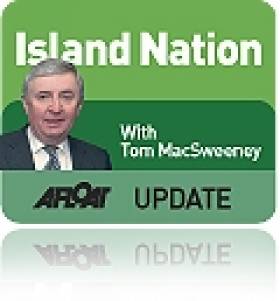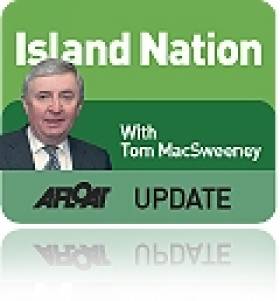Displaying items by tag: Tom MacSweeney
Government Ignores Its Own Islands & Maritime Reports
#islands – On Thursday, October 9, not enough TDs turned up in the Dáil to create a quorum for the business of our national Parliament. The Opposition accused the Government parties of being responsible and of showing lack of commitment to the affairs of the nation.
One of the affairs of the nation to which the Dáil shows lack of interest is the maritime sphere.
The Government is particularly culpable in this regard and is ignoring two reports which it commissioned on the maritime sphere and coastal communities.
I wrote last week about this neglect, questioning in particular the Government's dilution of maritime affairs by moving them into several departments.
This attitude is underlined by the manner in which it has refused to give time to discuss the Oireachtas Committee report on coastal and island communities which was presented to them in January of this year and the CEDRA Report which also made recommendations about maritime affairs.
The Oireachtas Committee which examined and reported on the Islands and Coastal Communities made a request for a national conference to be held by Departments with responsibilities in the maritime sphere. It also called for a debate in the Dáil and Senate on the issues it had highlighted of neglect and failures to support these communities. The Committee highlighted, amongst other issues, that State 'governance arrangements' were "not the best working model."
The Government has not given debate time nor have any of the Departments with involvement in the marine sphere done anything to organise a national conference involving those in the marine sphere to debate the issues. There were more than 30 recommendations in the report, ranging from maritime tourism to the seaweed industry.
Since the report was delivered the State company, Arramara, was sold off by Udaras na Gaeltachta. Questions have been raised about this, the sale has been subject to a lot of criticism, but there has been no Dáil or Senate debate on why another maritime resource, the property of the people of the nation, was sold to private interests. This was done despite the objections of seaweed growers who have alleged that their livelihoods were being destroyed.
Another maritime report by a Commission set up by the Government, which has been ignored since it was delivered, is the CEDRA Report (Commission for Economic Development of Rural Areas) which concluded that there should be 'plan-led' development of Ireland's marine territory to support economic targets and goals set out in the Government's Ocean Wealth Plan. It challenged the Government's commitment to this plan and whether it will, as a result, be effective.
The Chairman of CEDRA, former Kerry footballer and analyst Pat Spillane, did not know that the State company, Arramara, was being sold off by Udaras na Gaeltachta when his Commission recommended that the Government must set up "a regulatory development framework for the State's seaweed sector, both wild and cultivated," which would have economic and employment prospects for national benefit.
Neither did the Chairman of the Oireachtas Fisheries Committee, Andrew Doyle, T.D., know about the Government's agreement to sell off this State company and national resource, when his Committee made a similar recommendation to that of CEDRA's.
Both of these recommendations by State-appointed review bodies, were ignored by the Government. Is this not a clear indication of disregard for the maritime sector?
There are a lot of unanswered questions about how and why this sale was carried out and the effects it will have on the seaweed industry, such as why employment and potential economic benefits were ignored, as were those for whom it provided a livelihood.
Why has this sale not been made an issue for debate in the Dáil? Where are TDs and the national media in challenging aspects of it and asking for explanations?
The public reaction of the CEDRA Chairman to the Government's lack of response to his Commission's Report, which also made recommendations, as did the Oireachtas Committee, about the development of marine tourism and marinas, suggests that the Government's real commitment, away from the public relations spin, may be lacking.
In contrast to the frustration of lack of sufficient p Government focus and commitment to the maritime sector, there is the determination of people like Caitlin Ni Aodha from Helvick in County Waterford. In January of 2012 Caitlin stood on the quayside at Union Hall in West Cork when the Tit Bonhomme trawler tragedy occurred and her husband, Michael, and members of the crew died.

Caitlin Ni Aodha from Helvick in County Waterford
In the latest edition of my fortnightly half-hour radio programme, THIS ISLAND NATION, which you can hear here, I talk on the quayside at Howth to Caitlin as her new boat is launched, a 23-metre prawn freezer. She says that over the last few years she had learned a lot about life, about how good things happened, tragedies occurred, but life had to go on and it was important to do the best one can in life:
"People suffer tragedies, everything is not always easy. Michael and the Tit Bonhomme will be with me for ever. Every day I think of them, but I must do the very best I can with my life."
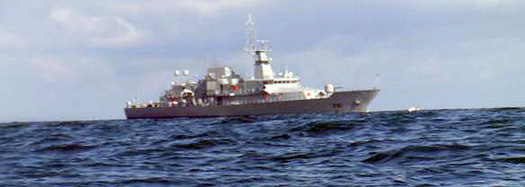
L.E.Samuel Beckett
It is not possible to maximise opportunities from the sea without a strong maritime culture. The Government and its officials could follow that approach to improve their attitude towards the fishing and marine industries. They could also listen to and benefit from hearing the determination of the man in charge of the State's newest naval vessel, Lt.Cdr.Tony Geraghty of the L.E.Samuel Beckett, on the programme. He outlines his determination to demonstrate the public the value of investment in the maritime sphere through the new ship. The ship is a positive State commitment, but the Government generally needs to do much more to show it appreciates that is responsible for the entire welfare of an island nation and to cherish all of its people equally.
Until next week, the usual wish of ..... "fair sailing" ........
Twitter: @AfloatMagazine @Tom MacSweeney
Island Nation Podcast – Widow of Skipper of Tit Bonhomme & Commander of Navy's Newest Ship
#islandnation – This month, Caitlin Ni Aodha, widow of the Skipper of the Tit Bonhomme who drowned in that trawler tragedy in West Cork, talks to us on the pier at Howth in County Dublin as she launched the new fishing boat she has bought about how she feels returning to the industry and overcoming the grief and tragedy.
The Commander of the Navy's newest ship, the LE Samuel Beckett, Lt. Cdr. Tony Geraghty, describes his role and how the ship causes him some concern when it goes quiet and uses the alternative electric motors instead of diesel to save fuel.
And we have reports from the RNLI and the Irish Water Safety Association.
This Island Nation is now broadcast fortnightly, the next programme will air on Community Radio Youghal and on other stations around the country during the week commencing the 20th of October.
Writing Fishing Women Out Of Existence, Ignoring Pirates & Limerick Slave Port
#islandnation – Why is it that women have been written out of the history of the Irish fishing industry and that in Ireland we ignore the economic opportunities which can be obtained from associating with pirates?
Those are two of the fascinating questions which arose at the symposium about the Irish Sea held in the National Maritime Museum in Dun Laoghaire on Saturday.
The "History, Culture, Environment" of the Irish Sea and whether it should be considered a place, a sea, or a connecting corridor of social, economic and trade importance between the people on both sides of the sea, would that seem a topic of general or limited interest to you?
It should be and what emerged during the day-long symposium was fascinating.
For example, they liked their smugglers in Rush in North County Dublin, so much that in the 1800s the Revenue could only get one man to remain in the village for any length of time before he was chased out, as the locals preferred the smugglers. But why, Joe Varley of the Institute asked, when presenting research done by Maighread Ní Murchadha about the Irish Revenue Boatmen from 1684-1766, do we Irish not make more of the opportunities which the maritime history about smugglers now makes available?
"I think we are a bit behind in the way we develop that. You go to Devon and Cornwall there is every escapade, whether real or made up, about smugglers. There are Smugglers' Coves, Smugglers' Inns, festivals about smuggling and they all attract people into the areas, so there is a great commercial potential. So why in the various parts of Ireland where there are smugglers' traditions, is that not used?
"They loved their smugglers in Rush. There were seven Revenue Boatmen in Skerries, seven in Portrane, eight or nine down in Malahide, all around the same area, in the 18th and early 19th centuries, which was the golden age of smuggling, but always just one brave soul in Rush and he wasn't very welcome! Indeed the locals weren't very welcoming to the Revenue generally and used them for their own purposes. In some areas those who operated as smugglers even gave them accommodation in their own homes as lodgers, so they would know when the Revenue were out on patrol and they could time their smuggling for when the Revenue were ashore!"

So, just think of all the opportunities around the coast to benefit from historical smuggling – not mind you the current type we have seen in recent years with drugs smuggling!
In the 18th century Rush (pictured below) was regarded as a "Smugglers' nest." One of the most well-known smugglers from there was Luke Ryan, born locally in 1750. He emigrated to France and obtained a commission as a Lieutenant in Dillon's Irish Regiment. After some time he returned to Rush and began operating as a smuggler between Ireland and France.

From 1775 until 1783 France sympathised with the Americans during the War of Independence and the French government commissioned Ryan as the Commander of a privateer, The Black Prince, which for several years plundered English ships around the English coast. In 1782 English forces captured Ryan and he was convicted in the Old Bailey in London on charges of piracy, smuggling and treason and condemned to death. He had a charmed life, however. Ordered to the gallows four times, four times he was reprieved. At the conclusion of the war, the French intervened on his behalf and secured his release. Unfortunately, his nest egg, some £70, 000, a lot of money at the time and which he had amassed from smuggling and privateering, was appropriated by French bankers. He died in a debtors' prison in 1789, where he was detained for a debt of £200.
Another Rush smuggler was Jack Connor, a native of Wexford, who practised his trade from what was known as 'The Smugglers' Cave,' located between Loughshinney and Skerries. Described as a "romantic and swashbuckling character," he was popular in high society and it was believed his cave held rich treasures taken during smuggling, but that it was guarded by a green serpent. The cave has never been properly located!
WOMEN CARRYING MEN ON THEIR BACKS
The women of the Claddagh in Galway were so powerful physically, that they often met their men at the boats when they came back from fishing and carried the men ashore on their backs, as well as setting the prices for the fish, cleaning and selling them.
"They were big, powerful women, the Claddagh women," Jim McLaughlin, a political geographer and social scientist, who has lectured at UCC for over 25 years, described them when he made the point that it was strange, because the fishing industry depended upon them, that women had been written out of its history.
"In old photographs you can see fish piled up on the pier, the women cutting and filleting them, the men in black suits who were the merchants looking on, ready to buy the fish."
But the women were disregarded as lower-class because they were doing the tough, dirty job of filleting the fish, blood and guts around the place and they were considered a bit wild. So is that where the 'fishwife' derogatory term came from?
"Women who worked in a men's world were considered of dubious background and quality and were crossing barriers. They were treated badly and their story should be told, perhaps starting with the photographs from around the fishing ports, but there is a huge job of research work and I don't see too many people rushing to do it, but women have been badly treated in the history of the fishing industry."
Professor John Brannigan of UCD's School of English, Drama and Film, one of the organisers of the symposium said he was surprised that, as Ireland had such a wonderful maritime heritage, we have no developed sense of studying that history. Maritime history is not an academic subject, whereas in the UK there are well-developed centres of maritime heritage.
"I am curious why that is the situation when people like to live by the sea, there is a clear value commercially from the sea, which is all very important to an island community which we are in Ireland, so there is a vast amount of research work to be done."
On the way back into Dublin on the DART from Dun Laoghaire I could see occasionally the Dublin Bay sailing fleet on the water for Saturday racing. But quite regularly it was cut off from vision by the high walls around the track and at stations. Unfortunate for a railway running alongside the Irish Sea.
TWO-HEADED DOLPHIN
Scientists have not been able to come up with a reason for a dead two-headed dolphin that washed ashore in in Izmir in Turkey, only the fifth known case of conjoined twins in dolphins. The rate of conjoined twins in marine mammals is less than one percent.
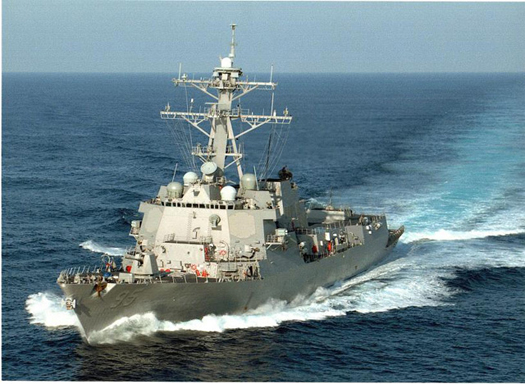
US NAVY SACKS MISSILE DESTROYER OFFICERS
The US Navy is continuing investigations into the situation that emerged aboard its missile destroyer, the USS James E. Williams, part of the 6th Fleet operating with the US Africa Command. The ship's Commanding Officer, Executive Officer and Command Master Chief, effectively the entire command leadership, were fired from their posts in a rare move, while the vessel was at sea, as a result of what has been described as "an on-going climate investigation." The ship departed her homeport of Norfolk on May 30 for an eight-month deployment.
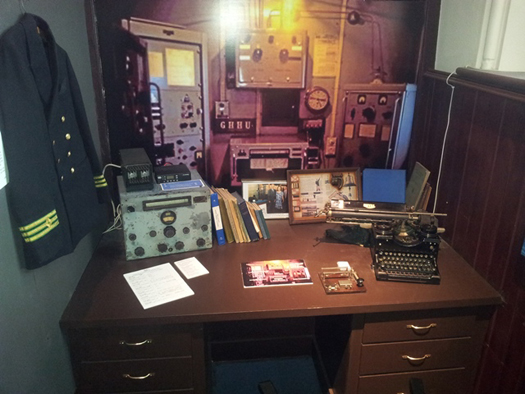
FIRST FOR IRELAND BY RADIO OFFICERS
Since its foundation in 1994, the Radio Officers' Association, for the former 'Sparks' of the sea waves, has grown to 400 members worldwide. For the first time, Ireland has been selected for a re-union of its members. This will take place in Dun Laoghaire on the weekend of November 21/22.
WHAT DO 'YACHTIES' WANT?
Fáilte Ireland is examining the coastal infrastructure in Ireland to find out what the expectations of sailors are. The tourist industry organisation has begun a market research initiative on consumer preferences for sailing, focusing on the infrastructure, facilities and services required to make Ireland a more attractive destination for sailing amongst domestic and overseas sailing enthusiasts.
LIMERICK A SLAVE PORT
While Ireland was never known to have been involved in slaving or having slave ships, research shows that in 1784 Limerick was the first Irish port to attempt to develop a slave-trade company. And in July 1718 a Limerick ship transported 96 slaves from Africa to Barbados, while two Dublin-based ships, the Sylva and the Sophia, were recorded slaving in the Gambia in May 1716. Africans being transported to Jamaica on the Sophia revolted, killing all of the crew except the Captain, according to historical reports.
So, a lot of maritime history this week.... Until next week, the usual wish of .....
"fair sailing..."
Email: [email protected]
Twitter: @AfloatMagazine @Tom MacSweeney
Preserving The Naomh Éanna, GPS Failure, & Buying An Island?
#IslandNation - Readers of this blog have been kind in welcoming me back to the airwaves, for which I am grateful. Community radio on which I now broadcast is quite a big operation about which I did not know a lot until I met the people who run Community Radio Youghal, CRY104FM, in the seaside town on the East Coast of County Cork. At their invitation I returned to the airwaves, broadcasting THIS ISLAND NATION every month and with more development now ahead, thanks to the positive response of listeners.
Every week 2,000 radio volunteers around the country engage with 307,000 listeners, broadcasting from 22 fully licensed stations, in addition to which there are a number of stations at different stages of development. Community radio is a rapidly growing broadcasting sector and a force for community development, identity and expression.
A community radio station is not focussed solely on broadcast schedules, which are subject to the diktats of commercial interests for advertising purpose. So it has a stronger focus on the values and interests of the community to which it broadcasts and can provide a wider variety of broadcasting. It appears to me that it can offer what is missing from mainstream media, newspapers, radio and television - and that is a regular forum for maritime news, information, comment and opinion, related directly to communities. The mainstream media, with a few exceptions, does not give sufficient regular, informed, balanced coverage of the marine sphere.
Transmission of THIS ISLAND NATION as a monthly radio programme about the sea, with the well-known signature tune ‘Sailing By', began earlier this year and interest has grown. ‘Sailing By’ was dropped by RTE as the signature tune for the programme Seascapes, which I had developed and broadcast there for over 20 years.
NEAR FM 90.3 community radio for Dublin North East and Raidió Corca Baiscinn 94.8 FM in County Clare also broadcast THIS ISLAND NATION, as does Afloat.ie on this website. I am hopeful that more community stations around the country will join in broadcasting the programme, for which the plan now, in response to growing interest, is to increase transmission from monthly to fortnightly from next month. CRAOL is the national representative body for the community radio movement.
With modern technology it is quite easy to listen to radio stations broadcasting from anywhere around the country. The app Tune In Radio, which can be downloaded from the Google Play store, is great for listening to radio anywhere. Download it and you have access to all radio stations on Adroid smartphones, tablets, laptops and desktops. That includes, of course, those which broadcast THIS ISLAND NATION.
PRESERVING THE NAOMH ÉANNA
After what has been a long battle against what seemed to be the complete disinterest of Government and State agencies in maritime heritage, Sam Field Corbett tells me that his Irish Ship & Barge Fabrication Company has acquired the heritage ship Naomh Éanna – “effectively securing the vessel for the next three months,” he says. “During this period IS&BF will complete the in-depth survey required to calculate the cost of repairing the hull and machinery to compliment the calculations for her refit as a boutique hostel, restaurant, cafe and museum.”
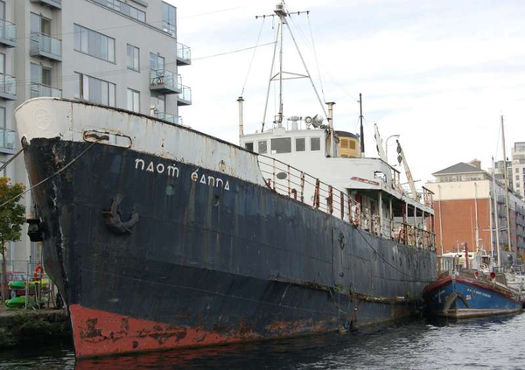
The Naomh Éanna was built by the Liffey Dockyard and launched in the late 1950s. Until 1988, it served as the Galway-Aran Islands ferry and had been operated by CIE. The vessel was purchased by the Irish Nautical Trust and moored at Grand Canal Dock in 1989 after it was decided that it could no longer operate as a passenger-carrying vessel.
Waterways Ireland, owners of the Grand Canal Dock, had determined to scrap the ship, maintaining that its condition was unsafe. WI had little interest in listening to proposals for preserving the ship. There was a debate about it in the Dáil which was told that the underwater archaeological unit of the Department of the Environment did not consider that the Naomh Éanna should be protected and disregarded the fact that it was “an example of the shipbuilding techniques used in the Liffey Docks in the 1950s”. That type of history, according to the Department, did not “justify the expense that would be involved in its preservation”.
Closed minds towards maritime heritage continue to dominate official circles but Sam Corbett refused to give up. Those supporting him had to fight against the attitude of officialdom which sought to exclude several of those who could be considered ‘stakeholders’ from meetings about the future of the ship, according to those who had an open mind the future of the vessel.
Sam Corbett tells me that “the final part of the negotiations” lies with NAMA “who seem close to issuing the three-month lease on the site which will allow surveyors to access the ship and determine her condition.
“Difficulties regarding a €50,000 bond in favour of Waterways Ireland should they be expected to step in and remove (scrap) the ship should IS&BF efforts to secure funding fail, may be close to being resolved. IS&BF presented Nama with an undertaking by a recycling company experienced in specialist breaking and NAMA are considering this option. We hope to have a decision shortly.
"IS&BF are intent on approaching a number of venture capitalists to invest in the project which is presented as a viable business. How the business plan is received by potential investors will ultimately decide the ship’s fate. We have chosen to approach potential investors who have an interest in supporting Irish heritage and jobs.
“This was the original proposition since we became aware the ship was going to be scrapped many months ago. It has been a long process. Without support it would not have been possible. Indeed, it would have surely been scrapped if it had not been for the direct intervention of TDs Kevin Humphreys, Sean Kyne, Joan Collins, Eamonn O Cuiv, Senator David Norris and Councillors Mary Freehill and Dermot Lacey among others.
"Many challenges lie ahead. However, it’s a great accomplishment to have got this far. The money donated by our supporters will be used to conduct the survey as planned and the reimbursement of this money to the RNLI has been included in the project costings. We hope to be able to invite all our supporters to visit the ship when she is being restored and look forward to meeting everyone then.”
Sam Corbett Field is the man who led the restoration of the former Cork Harbour liner tender MV Cill Áirne which could also have been destined for destruction but is now a floating restaurant on the Liffey in the Dublin Docklands near the IFSC. He is also involved in the operation of barges like the Riasc on the Dublin canals. He is not a man who gives up!
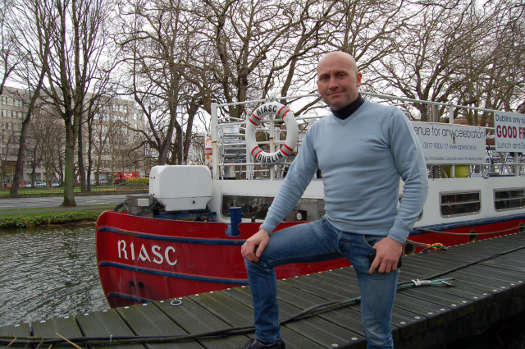
Sam Corbett Field by the Riasc on the Grand Canal
GPS FAILURE
It did not get a lot of public media attention at the time, though it was well-known in maritime circles, when the satellites in the Russian GLONASS GPS system failed for 11 hours last April. It was an unprecedented total disruption of a fully-operational satellite positioning service. As a result, the Russian GPS system was completely unusable to all worldwide GLONASS receivers.
The extent of the disruption has become clear following information released by the General Lighthouse Authorities of the UK and Ireland. GLA readings from their GLONASS receiver in Harwich showed location errors of over 30 nautical miles off the UK coastline.
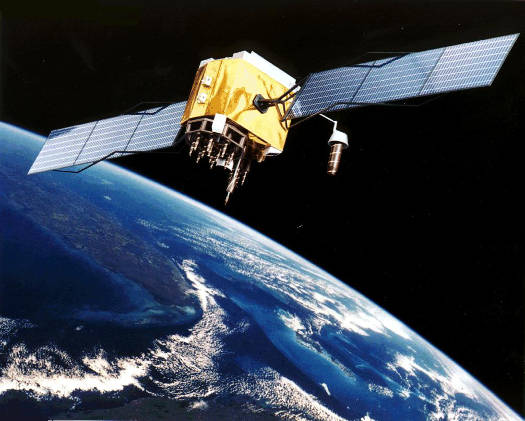
Apparently the problem occurred because of what were described as “bad ephemerides” being uploaded to satellites. Navigation messages from every satellite requires ephemeris data which is used by the satellite to check its orbital position and information about the time and status of the entire constellation. This data is then processed by user/receivers on the ground to compute their precise position. Less than a fortnight after the first failure, a second malfunction occurred temporarily knocking-out nine GLONASS satellites.
There are, according to information, quite a lot of GLONASS users, including some mobile phone systems. The GLA said that what happened “is a timely reminder that alternatives to satellite navigation are essential”.
The GLA themselves are supporting eLoran as an alternative to GPS for the UK and Ireland. This system transmits long-range position, navigation and timing signals from a ground-based radio network. Its primary use is for ships and others in the maritime sector, but it could provide a back-up for GPS, GLONASS and GALILEO (the long-awaited European system) when it arrives. But eLoran is still proving a hard sell to gain acceptance, according to those in the business.
A Royal Academy of Engineering report in 2011 declared that the UK was becoming dangerously over-reliant on Global Navigation Satellite Systems. Use of space-borne positioning and timing data is now widespread, in everything from freight movement to synchronisation of computer networks. The academy found that “too few of these applications have alternatives should the primary sat-nav signals go down”.
There is a detailed article about the failure of the GLONASS system and the implications for GPS in the September edition of Seaways, the international journal of The Nautical Institute.

BUYING AN ISLAND
There are a lot of interesting things happening along the Shannon, the latest of which is the decision of Clare County Council to buy Holy Island on Lough Derg, which is the largest lake on the River Shannon. The island has links back to Brian Boru. Called also the 'Jewel of the Lough', it is an important historical and ecclesiastical site, covering 50 acres of which four are in the ownership of the Office of Public Works. There are monastic ruins, including a 24m-high round tower, an oratory and church buildings. The island is still used as a burial ground. It is not far from the village of Mountshannon.
DRIFT NETS ABOLITION
The European Fisheries Commission wants to prohibit the use of any kind of drift nets for fishing in all EU waters from January of next year. It would also be made illegal to keep drift nets aboard fishing vessels. It is an all-embracing ban, typical of EU bureaucracy which does not give sufficient consideration before action to the socio-economic effects on, for example, coastal fishing communities, against whom its effects could be discriminatory.
While a ban on the abuse of these nets by big fishing boats from major fishing nations has had some positive effects on salmon stocks and protection of marine mammals, the EU and Irish Governments are ignoring the need, which is clear, for a comprehensive, long-term plan to be devised, with the involvement of local people, for the future of sustainable coastal fishing communities.
As an example of the disregard for coastal communities, the Government has still not responded to the Report of the Oireachtas Committee on Fisheries published last December that called for a Dáil debate and specific attention to be given by Government Departments to the socio-economic problems of Ireland’s coastal and island communities.
WHAT HAPPENS TO A SHIP?
Rarely does the general media report afterwards what happened to a ship aboard which a disaster has occurred. One such vessel was the MV MSC Flaminia, a German-owned container ship which caught fire on 14 July 2012, forcing the crew to abandon ship in the middle of the Atlantic Ocean. Three seafarers were killed.
Due to the damage and the cargo she was carrying, no country would give her ‘safe haven’ after the fire was put out. Eventually, nearly two months later, the German government had to respond to the requests of salvage crews and allowed the damaged vessel to be towed into Wilhelmshaven in Germany on 9 September.

The MV MSC Flaminia on fire in the mid Atlantic
In March 2013 she departed Wilhelmshaven for the Daewoo shipyard at Mangalia in Romania, where repairs were carried out. They were completed this July and the Flaminia, a post-Panamax container ship with a capacity of 6,750 TEUs and deadweight tonnage of 85,823 tons, 980 feet long and 130 feet wide, drawing 48 feet when fully laden, has returned to service. The repair work on the badly-damaged vessel included conversion into a modern eco-ship to reduce fuel consumption.
Email: [email protected]
Twitter: @TomMacSweeney
Why Does The Central Bank Not Recognise Marine?
#islandnation – Having written last week about the lack of national recognition for our maritime heritage I received a press release about the Central Bank honouring John Philip Holland, the Irish inventor of the submarine.
I am pleased to see that the Central Bank has taken such a step but, perusing the media releaseon the Central Bank website, I noted the quote from the Central Bank’s Director of Currency and Facilities Management, Paul Molumby: “This is the first in a new series that the Central Bank will issue to honour Ireland’s impressive scientific and technological tradition.”
Not a single reference by the Central Bank to the great maritime tradition of Ireland in launching the coin about an invention, fundamental to which was the marine sphere.
Mr.Molumby is quoted further as saying that “John Philip Holland’s life and achievements were extraordinary. He played a significant role in the development of submarine navigation and following his emigration to the USA, he designed the first working submarine.”
Indeed, he did, but Mr.Molumby and the Central Bank omitted mention of the marine in the technological development they were honouring.
At least the Bank went to the Marine Institute in Galway to launch the coin.
The Institute issued a press release with the same quotation, but Dr. Peter Heffernan, the Institute’s CEO, did mention at the launch that Ireland has “a strong tradition of innovation and we at the Marine Institute are very proud to maintain that link with the history of marine technology. We named our remote operated vehicle (ROV) after John Philip Holland.”
This ROV honours the legacy of a man who used the maritime sphere for innovation, but the Central Bank in honouring him do not even use the word ‘marine.’
The Marine Institute is using the ROV on surveysof mid-Atlantic volcanic vent fields and new animal communities on the deep canyons of our Continental slope, as well as working on crucial fisheries, environmental and climate changes and assisting in the development of new marine sensor technologies.
The Central Bank is charging €44 for the €15 coin according to the press release.
Am I being tendentious in making this point?
Perhaps, but where there is neglect of the maritime sphere at the highest levels, it should be challenged and the more it is, the more those disregarding our maritime traditions and potential will be forced to change their attitude.
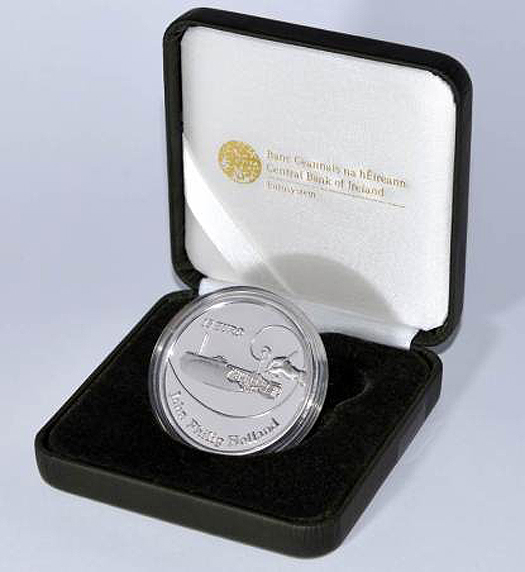
While the issuing of the coin (pictured above) is welcome, I respectfully suggest to the Central Bank that it acknowledge the maritime sphere and note that Holland’s invention relied fundamentally on the marine.
FISH GUTS AND DIESEL AND THE RESTLESS SEA
Have you ever wondered what it’s like to be a fisherman? With Autumn having arrived and Winter not far behind, life on the ocean wave can be tough, rolling and plunging as the boat hits heavy seas while fishermen struggle with lowering and hauling of nets to catch the fish which we can eat in more pleasant surroundings.
Paul McDonald is a songwriter who wrote much of his work in the heart of Dublin, where he had a cottage in Copper Alley. But he also had experience as a fisherman out of Galway. The song, “Fish Guts and Diesel,” on his CD ‘Crazy Old World’ tells his story of life aboard a trawler many miles out to sea off the West Coast – on the Porcupine Bank. You can hear it on this month’s edition of THIS ISLAND NATION (above), my monthly maritime radio programme that is broadcast on a number of community radio stations.
“As long as I live I’ll never forget the smell of that combination of fish guts and diesel,” he said.
There are some beautiful lines in the song which anyone who has kept a night watch at sea will empathise with:
“Sometimes in the dark as you gaze in the night,
Your mind’s in the stars as your thoughts they take flight
And then a Force Seven brings you back down to earth
And you battle the elements for all that your worth.”
You can hear the song at the start of this month’s programme. As I broadcast it, I could almost see those dead fish eyes which he sings about, staring up at me from the catch hauled aboard. Having been on a few trawlers in my time, occasionally in not-too-pleasant conditions and even though I sail and have sailed in rough weather, I admire hugely those fishermen whose stomachs, I think, must be made of cast-iron to withstand the conditions in which they have to work. I think anyone with an interest in the sea will like the song.
FOREIGN BOATS COST IRELAND OVER A BILLION EUROS
Incidentally, the huge value of fish caught in Irish waters by fleets from France, Spain, Portugal, Holland and the UK, is shown by the figures which the Department of Agriculture, Food and the Marine has released for catches taken last year from around Ireland. The total value was €1.16 billion. That would be hugely valuable to this nation’s economy, but regrettably Ireland’s share of this catch was only 17 per cent in value. The total catch taken from Irish waters 1,040,117 tonnes, but Irish boats were allowed by EU regulations to catch only 23 per cent of this tonnage. These figures prove just how much the EU gets in monetary value from Ireland. Little is heard about this from economic commentators or politicians who tell us how grateful we should be to the EU, but the reality is that the EU gets a lot of money from Irish waters. Our fishing industry, rather than shrinking in size, should be much bigger, with economic and employment benefit, if the riches of Irish waters had not been given away by Irish governments .Tellingly, the summary line in the figures compiled by the Department says that the economic value of €1.16 billion which they quote for fish caught in Irish waters “… represents a conservative estimate.”
BROADCASTING FROM THE COASTLINE
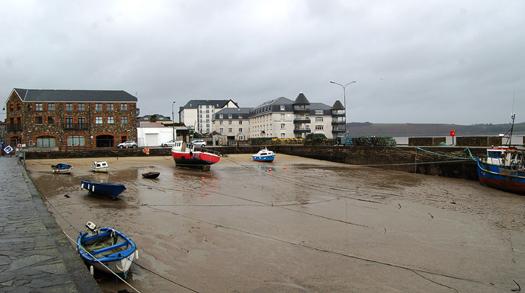
Youghal seafront
THIS ISLAND NATION is broadcast from the studios of Community Radio Youghal on the coastline of East Cork and the banks of the River Blackwater. I mention on the programme W.M.Nixon’s story about the GP 14 sail up the Blackwater from Youghal, which was reported on Afloat last week. This has raised interest in the sport. The Kathleen and May will be remembered as the great schooner which linked Youghal with the UK and there are many other stories of Youghal seafarers in a town with a great maritime tradition.
Next month, following listener interest, the programme will increase its slot from monthly to fortnightly.
SEAWEED IS NOT JUST A WEED

Also on this month’s programme I talk to The Sea Gardener, Marie Power (pictured above), in Tramore. She grew up on what’s known as The Copper Coast of County Waterford, a fascinating part of the countryside and has been running seaweed workshops for several years on a voluntary basis, even though her professional background is in management and training consultancy. Seaweed is not just a weed she says – and she is very definite about that. Listen to hear more.
HALF THE COUNTER IS FARMED
Nearly half of the fish which the public sees on fishmonger’s counters has been farmed. So Richie Flynn, IFA Aquaculture Executive, told me when I interviewed him. “This is something which should be encouraged for the future of coastal communities right around the coast,” he said, but added that the Government’s attitude towards licensing “is still a problem for aquaculture development.”
Email: [email protected]
Twitter: @Tom MacSweeney
Clouds & Fighting 'Blue–Sky' Thinking
#clouds – Clouds can be unjustly maligned. Life would be immeasurably poorer without them.
They are expressions of the mood of the atmosphere and can be read like the moods of a person's countenance.
"Clouds are so commonplace that their beauty is often overlooked.
"They are for dreamers and their contemplation benefits the soul."
"All who consider the shapes they see in them will save on psychoanalysis bills".
I am member number 11,767 of a pretty unique society from the Manifesto of which the above comments are extracts. It is a society which seeks "to persuade all who'll listen of the wonder and beauty of clouds."
It is ten years ago this Summer that the Founder of The Cloud Appreciation Society, Gavin Pretor-Pinney, gave a lecture which began it at the Port Eliot Festival in Cornwall. He was back there a couple of weeks ago, reviewing the events that have shaped the Society and, as he said "rocked the cloud world over the past ten years."
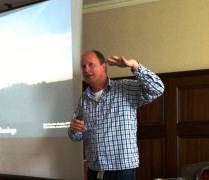
Gavin Pretor-Pinney founder of the Cloud Appreciation Society
The Cloud Appreciation Society has a touch of wry humour about itself as evidenced by its promotional statement:
"We love clouds, we're not ashamed to say it and we've had enough of people moaning about them. We are fighting the banality of 'blue-sky thinking'.
It does not take itself too seriously and there are members, like myself, who quite like blue skies and the nice sailing weather that goes with them.
But there is a fascination with clouds and their appearance.
There is also a serious aspect to understanding the clouds where sailors are concerned. Being able to read them helps indicate what weather may be expected, changes that may come quickly and catch one unawares.

A Sunrise over the Muromi River, Fukuoka City, Japan. by Junichi Kai - from The Cloud Appeciation Society gallery
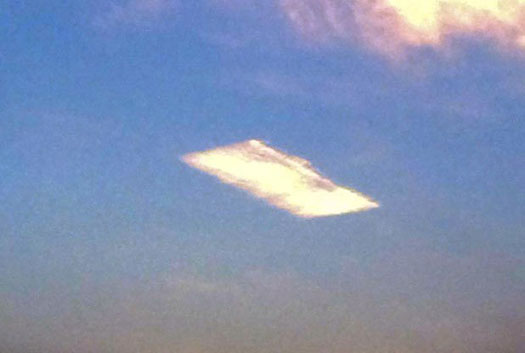
Flying carpet cloud - seen this week in uk - from cloud appreciation society photo gallery
"Mackerel scales and mare's tails, make lofty ships carry low sails."
That, or various interpretations of that particular quotation, are well-known to many sailors. But how many can tell a Cumulus from a Cumulonimbus ?
Or a "Mamma", the udders of a cloud from a "Nacreous" – 'mother-of-pearl' clouds ?
Or an Incus from a cirrostratus undulate?
I certainly can't, but I know that there are also stratospheric and mesospheric clouds and from the Cloud Appreciation Society I have learned one thing – it behoves anyone going out in a yacht or a boat of any kind to be able to understand the pattern of cloud behaviour.

A sighting of Elvis Presley, spotted over Samburu National Park, Kenya. by Colin McDerment Cloud Appreciation Society

A cloud that looks like Aladdin's Lamp over Clovelly Surf Club, Sydney, Australia. by Nick Andrews in the Cloud Appreciation Society photo gallery
I am still working on that myself!
The First Irish Cloud Festival was held in West Cork by the Irish chapter of the Society in 2011.
"The Cloudspotter's Guide" was the first publication of the Society, described by The Sunday times as: "Go cloudspotting, it's the new religion." It introduces each of the different 'characters' in the 'cloud family', to help readers understand the predictions for weather which they provide. Clouds are used to predict earthquakes and there has been one in Australia which glider pilots surfed like a wave.
And if you have wondered who would win in a clash of clouds between the stormy Cumulonimbus thunderclouds and the drizzly Nimbostratus, this is where the answer can be found.
"I've always loved looking at clouds, Nothing in nature rivals their variety, drama and sublime ephemeral beauty," says the Society's Founder and, with that wry touch of ephemeral comment, wit and humour which encourages membership like mine, adds: "The clouds deserve better than to be regarded merely as a metaphor for doom. Someone needed to stand up for clouds, so I started the Society devoted to doing this."
The worldwide membership of the Society is now 35,796. Membership includes professionals such as meteorologists, merchant mariners, other professionals, leisure sailors but mostly those with no professional qualifications, just an interest in clouds.
Before the invention of modern weather instruments, seafarers relied on observations of nature to predict weather. In these modern times there are weather forecasts on radio, in the papers, by coastal and Coastguard radio stations, on television, in the papers, available on mobile phones apps, national weather services, satellite photographs, but a mariner should also understand seasonal weather patterns and be able to read signs in the environment both before and during a trip. The wind, sea state, clouds all give clues to current and approaching weather. The art of non-instrument weather forecasting can be used to confirm weather reports or to predict weather when instruments and reports are not available.
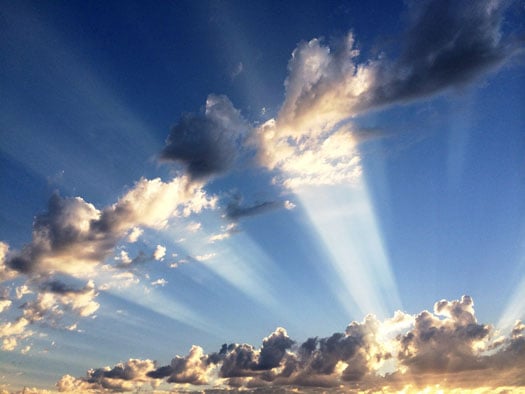
Cloud illumination over lake Seattle, USA - from the cloud appreciation society gallery
Tragedies at sea, as happened again this week in West Cork, are terrible. The sea is unpredictable, so is the weather. It can change rapidly, particularly across our island which is so exposed to the effects of the Atlantic and associated weather patterns, particularly on the South and West Coasts from where much of our weather patterns arrive.
"The very shadows of the clouds have power to shake me as they pass," wrote William Wordsworth.
Understanding them is worthwhile.
And - Are Mackerel Scales and Mare's Tails good predictors of approaching storms?
The answer is 'yes,' because cloud systems that develop prior to a storm will often appear lumpy and wispy like a fish scale or a horse's tail!
So now you know.
I am still learning.
Clouds are Nature's poetry, the most egalitarian of her displays. Everyone can have a fantastic view of them.
Life would be dull if we had to look up at cloudless monotony day-after-day, so says The Cloud Appreciation Society.
Fair sailing until next week..... and keep an eye on those clouds!
Email: [email protected]
Twitter: @Tom MacSweeney @Afloatmagazine
This Island Nation Podcast by Tom MacSweeney: August
#islandnation – In this month's programme we have the story of a Soviet take-over of Cork Port, hear that love is in the air at the country's lifeboat stations, with the 45th station due to open shortly; we go to Ireland's longest river, the Shannon, where a boat made famous by Wolfe Tone is being launched; tour Ballycotton Lighthouse, open to the public for the first time and hear about its association with the Irish ship which made the first crossing of the Atlantic by steam; and we discuss whether a Tall Ship is the best method of sail training.
#rorcbdcc – At a time when the future of Irish sailing is under examination by the sport's national association, the Irish success in winning what has been described as the world cup of offshore racing, the Commodore's Cup, is in my view, a considerable boost.
The 'spirit of sailing' appears to be under a degree of challenge at present, though it seems from talking to clubs and groups around the coast that the picture is not gloomy everywhere. However, there is an undeniable loss of numbers in quite a few clubs, a few of them major ones and racing seems to be taking the brunt of this.
It was interesting therefore to meet the Skipper of Team Ireland which won this top trophy in the home of British sailing, for the second time. Anthony O'Leary, members of the Irish team and officers of the Irish Cruiser Racing Association, were given a reception and 'welcome home' with the Cup at his home club, the Royal Cork in Crosshaven on Thursday night.
Those of us who had been competing in the Thursday night league that evening were back ashore at the end of racing, to be part of the occasion and it was interesting to hear Anthony reflect on the background to how the trophy had been won and the planning and commitment required of all those involved. He spoke of the value of learning sailing from an early age and remaining with the sport, but also of the dedication and demands which must be endured to be successful. Sailing can be developed as a lifetime sport from the days of youngsters in Optimists through to the highest levels of the sport, was his message, an issue also referred to by RCYC Admiral Pat Lyons and by the Commodore of the Irish Cruiser Racing Association, Norbert Reilly. These comments must have reflected on the thoughts of Irish Sailing Association President, David Lovegrove, who was also at the RCYC event.
The drop-out of younger sailors appears to be at the core of difficulties in several clubs, where keeping them involved is proving difficult. Perhaps it is the variety of boats or the lack of a pathway in the sport other than the higher competitive levels, or are some younger sailors being driven too hard towards trying to achieve winning as the only mark of being successful?
It will be difficult to resolve these questions but the sport needs to do so and particularly to ensure the involvement of younger sailors.
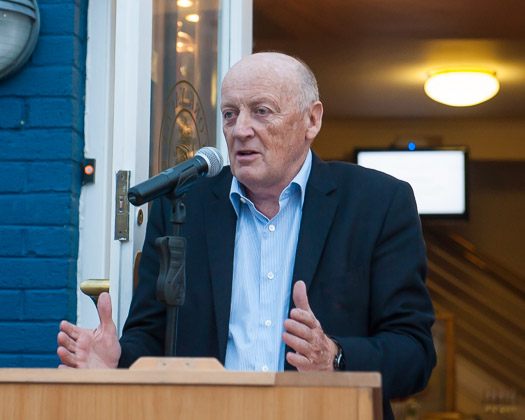
Norbert Reilly of ICRA at Royal Cork Yacht Club
So, what is the 'spirit of sailing'?
'A man must be obsessed about something and a boat is as good as anything.' That quote from E.B.White, an American editor and writer has often been used to summarise the spirit of sailing though, let me be clear that I do not see sailing as a male preserve, nor obsession with it!
E.B.White also wrote about arising in the morning "torn between a desire to improve the world and to enjoy it, which makes it hard to plan the day."
That can occasionally make the choice of going sailing against deploying oneself to more mundane household or even work demands difficult and potentially awkward in domestic relationships!
Most important of all, in my view, is enjoying going sailing. I have always taken the view that, if it is not enjoyable and if one has doubts about going out on a boat, then don't do so. We can be put off by unpleasant weather, though sometimes there is a need to endure it and if one is only involved in cruising, perhaps the boat may be used less than when the disciplines of racing bring a crew together.
An example of this thought process for me was on last Tuesday night when I was invited to take part in the annual Media Challenge organised by the ISA and Providence Resources at the Royal St.George YC in Dun Laoghaire with members of the Irish Olympic Squad. It was a bit blustery when Bill O'Hara as Race Officer outlined what the night's racing would involve in 1720s. These are a pretty demanding keel boat which move quickly. I had not helmed one before and found it challenging, but definitely enjoyable in the prevailing conditions.
Everyone involved declared that they had a good night's sailing though, if one was not involved in racing, one might have stood back, looked at the conditions and thought that remaining ashore was a better choice! But, when you do go out, it most often proves that sailing is fulfilling, can be enjoyable and that it is necessary to understand and attempt to master different conditions.
RED SAILS COMING BACK?
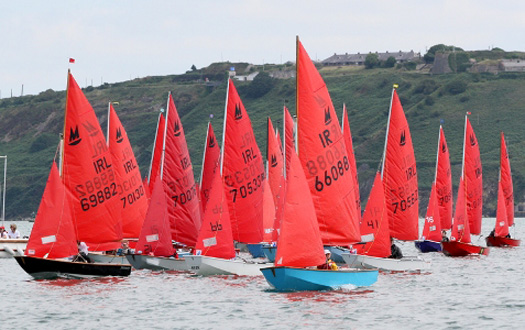
Mirror racing is back in Cork Harbour
Another boat I enjoyed seeing was the Mirror, back racing in Cork Harbour for their Southern Championships, sailed out of the RCYC at Crosshaven. It was good to see the red sails of the Mirror dinghies in numbers again. There were 23 boats, with 46 sailors in all ranging in age from 14 to 50+ It was the biggest turn-out for the 'Southerns' in years, I was told. The first boat I ever owned was a Mirror, which I sailed out of Monkstown Bay Sailing club. They are a great dinghy.
Mirrors hadn't sailed out of the RCYC since 2005. A few former 'Mirror sailors,' now with children of their own, decided it was time to get the boats they had once sailed out of hibernation and see if they were still fit for purpose. Both sailors and boats seemed to be and there is some thought that the event may lead to a revival of interest in this dinghy class in Cork. There was a lot of discussion at the event about the changes from the original wooden boats to the present fibreglass dinghies, with consequent changes in equipment and rigging.
"There is no doubt that the plastic Mirror is a fine design, but a good wooden boat can still challenge them," one of the 'woodies,' said. Indeed, a wooden boat from South Africa won the Mirror World Championships held at Lough Derg Yacht Club last year.
And of course, young Irish sailors have been victorious in the Mirror World Championships.
THE SPIRIT OF KERRY IN OMAN
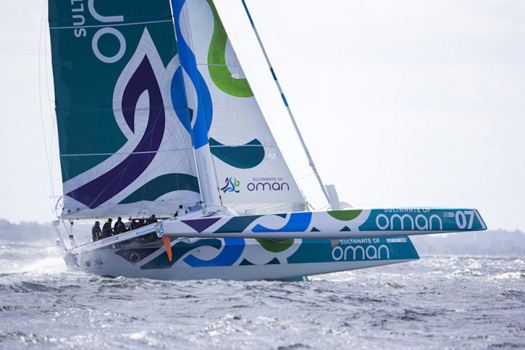
The Oman MOD 70 where Kerry's Damian Foxall (below) is co–skipper
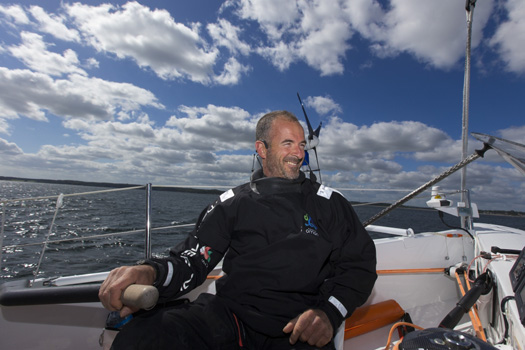
Then there is the spirit of Damian Foxall from Kerry, one of the world's top sailors, who is Skippering the MOD70 of Musandam-Oman Sail in the Artemis Challenge in Cowes Week in the Solent. This is part of the Oman Sail project for which he is working. It is that country's national initiative established in 2008 which "uses the power of sport to contribute to the development of the Omani people," the government says. It is an "equal opportunity project" which runs sailing programmes "for thousands of young Omani men and women, aimed at inspiring a new generation to discover sailing, encompassing a national sailing squad and high achieving inshore and offshore racing teams, all of which benefit from world-class coaching and whose ultimate objective is to win an Olympic medal for Oman." The programme is pledged to teach 70,000 Omani children to sail by 2020 at eight sailing schools, four of which are already operational:
"The goal is to rekindle Oman's maritime heritage while raising the country's regional and international profile as a high-end tourist and foreign investment destination, through competitive sailing at home and abroad. Oman Sail seeks to instil confidence and to teach valuable, transferable life skills to a generation of Omanis."
Wouldn't it be marvellous if this island nation had such a State project and saw its national maritime traditions in such a manner?
Damian Foxall is co-Skipper of Musandam-Oman Sail which is part of the project. The Skipper is Sidney Gavignet of France.
For the past month, Oman Sail skipper Sidney Gavignet (FRA) and a mixed squad of Omani and European sailors have been at the centre of a tough series of inshore and offshore races around the French coast in conditions that varied from very light to downright stormy and produced their best performance since they first entered the event in 2008 by finishing third.
"We had a tough Tour de France, but pulled it off in the end through good team work, our squad really pulled together and we are very happy with the result!" said Sidney Gavignet.
After the Artemis Challenge they will take on the Round Britain and Ireland Race, where a line honours win is their goal.
Jan Dekker, the highly regarded America's Cup and Volvo Ocean Race veteran from South Africa will be with Damian on the MOD70 in the Artemis Challenge.
Gavignet set a Round Britain and Ireland non-stop singlehanded record set in 2010 on the 105ft Trimaran, Oman Air Majan.
"We are looking forward to the Round Britain, it is a challenging race and will be the last crewed race for us before I turn to solo training for the Route du Rhum at the end of the year," said Gavignet.
NOT EVERYTHING IS RACING
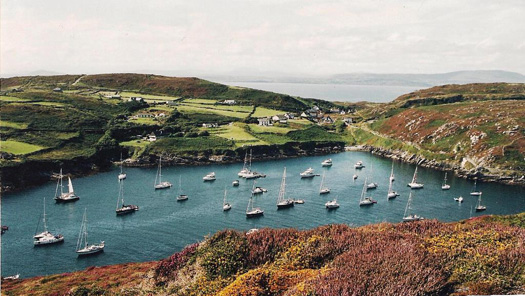
South Harbour on Cape Clear on a busy day
But sailing cannot and should not be dependent exclusively on racing and for the next few weeks the annual trek to West Cork beckons sailors from many parts. As one matures, gets older some would say and the joints do not bend or flex as easily as they did in years past, cramped conditions aboard cruiser/racers can be challenging. But there is the counterbalance of the enjoyment of leisurely time in places like South Harbour, Cape Clear, which is one of my ideal locations; at Sherkin Island, Baltimore, Schull and other places. Glandore is quieter these days than inprevious years for visitors, with the village hotel and the Glandore Inn, which had been sailors' main location on arrival in the village closed. The hotel is up for sale. Other pubs in the village are open and Glandore Harbour Yacht Club has its own clubhouse now. There are sunsets and sunrises to be discovered, early morning sailing in quiet areas and the enjoyments of cruising without time disciplines. [Read WM Nixon's recent sailing blog on West Cork]
WHAT A SHARK PICTURE!
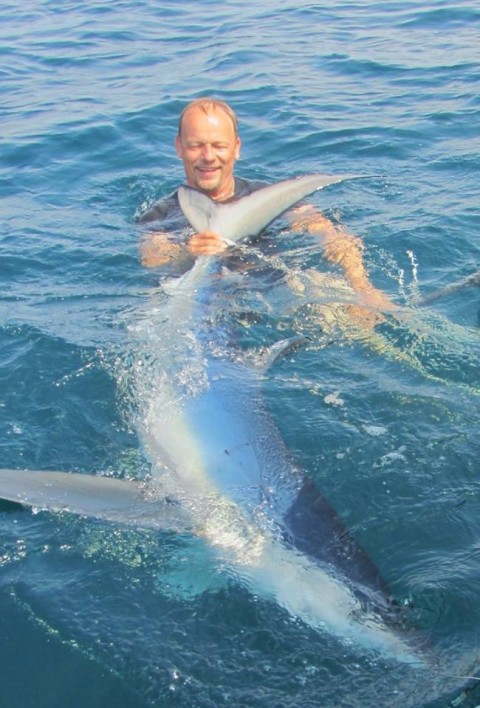
Nice catch!
This is some photograph, of an angler in the water with a blue shark. Paul Bourke, Angling Information Officer with Inland Fisheries Ireland explained to me: "Jim Clohessy was out with some Norwegian anglers last week fishing from boats in the Bellavista fleet in Cork Harbour. Amongst this intrepid crew was Hans Olav Hagerup, an angling guide himself. Hans explained to Jim how his anglers, fish, catch and release for big halibut and as these fish are too big to get in the boat for a photo, the anglers get in the water instead. Little did Jim know what this would lead to when Hans had his first Irish blue from a small boat and jumped in the water! He won the Fisheries Ireland Catch of the Week for this one!
NEXT THIS ISLAND NATION RADIO PROGRAMME HERE ON AFLOAT: August 7.
#tallship – The first Bantry Longboat ever built in the Midlands will go sailing on the Shannon at Banagher in County Offaly. It will be some sight when it does, bringing involvement with the Atlantic Challenge which organises international competition of these boats, to what can fairly be described as Ireland's greatest river system.
If that major event should itself be held in future years on the Shannon, what a great occasion it would be.
I met some of those who built it the Banagher Longboat at the Glandore Classic Boats Summer Maritime School where one of them, Noel Ryan, told me that it took 5,036 man hours. Another of the group, Willie Kirwan, added that they would have "done it quicker if we were tradesmen, but we were all learners without experience, so we had a lot of tea breaks! If we were tradesmen we would have been quicker, but we enjoyed it and we have a fine boat."
They have indeed and those who built it will be testing it out in August. "We want to make sure it goes well, we wouldn't want any embarrassment," said Willie jovially, "but we are sure it won't sink, though we will have to learn about the skill of rowing and sailing this boat."
Indeed they will. I had the pleasure of sailing in the Bantry Longboat which was built in Bantry a few years ago. When it sailed on a reach it could reach a pretty quick speed and I found it was the skill of the crew in balancing the boat which kept it upright. You needed to be lively, as the longboat doesn't have a keel.
"We learned a lot, new things every day, building a boat can be tough and demanding but it is definitely enjoyable and rewarding when you see it finished," Noel said.
They have a lot of pride in their boat which was built with as the West Offaly Bantry Bay Longboat Project, originally a Men's Shed initiative with support from Offaly Local Enterprise Development Company, West Offaly Enterprise and County Offaly VEC, the latter of whom apparently thought the job might be done in three months!
The boat has led to the formation of the Midlands Atlantic Challenge Club, which intends to organise involvement with schools, youth, sports and corporate groups.
Twelve countries are members of the Atlantic Challenge organisation – Belgium, Canada, Denmark, Finland, France, Great Britain, Indonesia, Italy, Russia, USA, Ireland and Northern Ireland are separate members.
The original longboat, also known as an admiral's barge, was built in Brest, France, over 200 years ago. The boat is similar to the Captain's gigs used at that time by the navies of France, Sweden, Russia, Spain, Sweden and the USA. When the French Armada arrived off the South/West coast of Ireland in 1796 it ran into a gale and, through lack of leadership, decided to return to France. But the longboat from the vessel which Wolfe Tone was aboard, while trying to establish communication with other ships, was blown ashore in Bere Island and the crew were captured by British forces. This boat is preserved in the National Museum at Collins Barracks in Dublin. Built in1790, it is the oldest surviving vessel of the French Navy.
So, what have these Bantry Longboats got to do with whether Ireland should have a tall ship?
Hal Sisk, legendary figure in the traditional boats sphere and a man never reluctant to take and express a different view and to advance that, even if controversial, was also speaking at the Glandore Summer School in his role as sailor, author and yachting historian, on the topic: 'The origins of the sport of modern amateur sailing.'
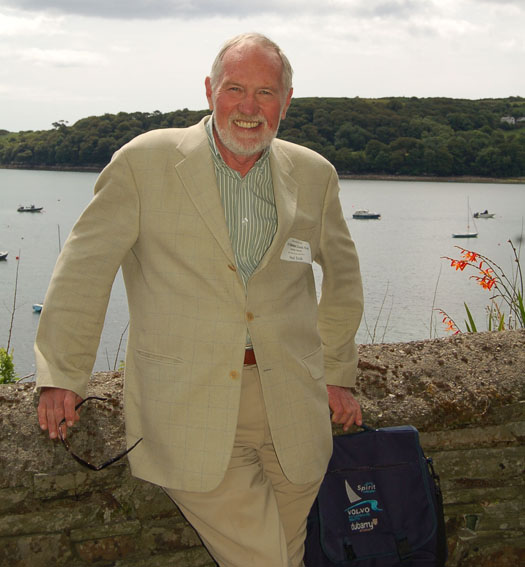
Hal Sisk
Hal advanced a different view about the thrust of sail training than Ireland having a tall ship for the purpose:
"To get people out on the water, in a team concept, providing physical exercise and with international competition, all of that could be achieved with an alternative of a fleet of 30 Bantry Longboats, several of which have already been built in Ireland. There are 35 worldwide and a fleet of them in Ireland would provide, at dramatically reduced cost, what a sail training ship delivers in sail training."
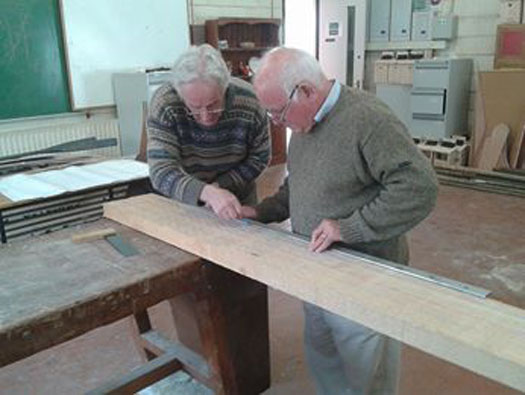
Building The Banagher Bantry Longboat
I put it to him that this would exclude the role of international representation which, for example Asgard had done well and, in modern terms, requirements to provide for disabled trainees.

Bantry Longboat Fionbarra
"I acknowledge what you say, but these boats have fantastic international competition. They are all built the same wherever they are, whereas in the race of sail training ships, it is pretty much based on handicap, it is not a race between identical boats. The Bantry longboats provide this, they come together every few years in international competition and have been built far away, in Indonesia, Russia, for example. You would get true, fair, international competition. They don't fly the flag in a spectacular way in international representation terms as Asgard did for example or as does a beautiful square-rigged tall ship, but there always was an alternative in the replacement of Asgard after she sank.
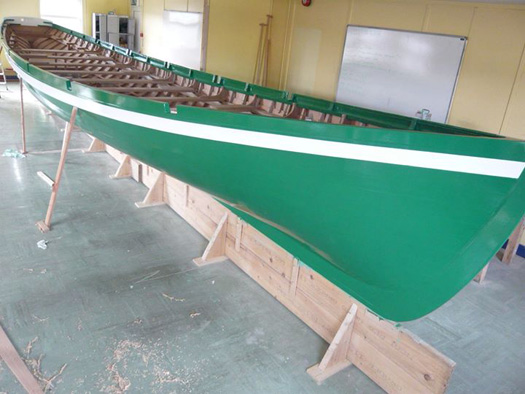
The Banagher Bantry Longboat
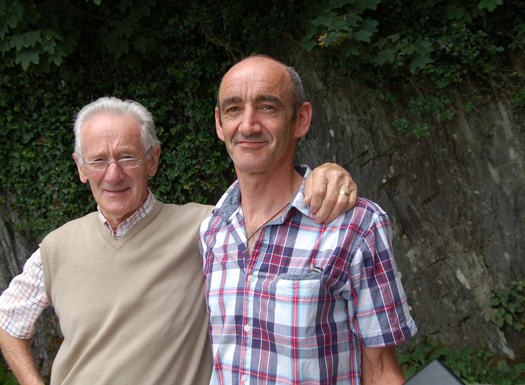
Willie Kirwan And Noel Ryan - Banagher Boat Builders

The Oldest Vessel Of The French Navy - The Original Bantry Longboat In Ireland's National Museum
"Ireland could have bought a steel-hulled topsail schooner for about €2m, or so and have her for that function, but I would argue that, as against the building of a new tall ship we could build a fleet of Bantry Longboats. We must also remember the cost of maintenance and operation of a tall ship, crewing and health and safety requirements. But a fleet of Bantry longboats would be out on the water far more often probably and could be built for maybe a million and would provide more use for more trainees and the cost, against that of a sail training ship, would not be just very much less, but substantially less by my calculations."
Hal has sent me statistics to make his point - that actual use and benefits in providing sail training and general seamanship for many more young people would be at much less cost for a fleet of 30 Bantry Longboats compared to a tall ship and would be of much greater benefit.
"Bantry Longboats could be spread around the country, built locally and therefore also building on town and parish pride and maintaining coastal traditions also. It is a historic boat, authentic, distinctive, with that huge international competition dimension."
The case Hal Sisk makes is interesting, while at present efforts continue through what was formerly called the 'Pride of Ireland Trust' now changed to the 'Atlantic Youth Trust,' to build a new Irish tall ship, the concept design for which has been completed. The name change followed consultation on both sides of the Border, after which it was decided that 'Pride of Ireland Trust' did not represent the views of all stakeholders and "therefore did not represent the ethos of the organisation, so in order to create a name that has a true sense of neutrality, a strong maritime focus, a sense of adventure and one that carries weight in America, 'Atlantic Youth Trust,' was chosen as the name to offer unique Youth and Cultural Development opportunities, to help the island reach its maritime potential and to create a flagship that will represent the island on an international platform," amongst other aims.
I will be interested to hear response to the views of Hal Sisk.
THE GOVERNMENT IS HOLDING €3.8m. IN ASGARD COMPENSATION WHICH IT SHOULD RETURN TO THE MARINE SECTOR
It remains a blot on the maritime reputation of this island nation that the €3.8m. insurance paid for the loss of Asgard was put into general Government funds by former Defence Minister Willie O'Dea, rather than being held for the specific purpose of a replacement national tall ship, even if that would be provided outside of Government.
I was never impressed by the administration of Asgard during my years as a national marine correspondent. I expected far more commitment and determination in support of the maritime interests of this nation. When Willie O'Dea appeared to confuse 'vehicle' and 'vessel' in his answers on a radio interview about the sinking of Asgard, then refused several attempts by me to get an interview with him about his decision in regard to giving the Asgard insurance money to the State and other decisions he made when the equestrian requests of the Army for horses, were considered more important than Asgard, I realised that the Limerickman who declares on his website - 'Working for You' - did not show much commitment to working for the national tall ship. I offered to go anywhere, anytime, to interview him, but through his officials, he always found a reason not to be available.
Whether for Bantry Longboats or for a tall ship, it is my view that there is €3.8m. in State funds which is morally due to either project and the Government should acknowledge and provide that.
No less is required of the Government of an island nation.
Who Is To Blame For The Decline in Sailing?
#sailing – Sailing is a sport, not the qualification of a superior social standing.
Is that fully understood by everyone involved in the sport or is there still an element of elitism which needs to be eradicated?
The term 'yachting' was dropped a few years from the title of the national representative organisation which became the Irish Sailing Association, amidst an apparent belief that 'sailing' would be less elitist as a descriptive term and more acceptable to the public.
Most 'yacht' clubs did not become 'sailing' clubs, though there are more 'sailing clubs' it would seem than 'yacht' clubs around the country. Boats did not generally become described in the American term of 'sailboats' but remained yachts.
I see no major problem with the term 'yachting' though I understand the sensitivities which surround the different terminology. I have no qualms about admitting that I own a yacht and feel fortunate to do so.
What is of more concern to me is that the sport becomes truly a 'sport for all' and is not riddled with different levels of social strata.
There remains a degree of public perception that sailing is an elitist sport. This has dogged it gaining more general acceptance and bedevilled its reputation.
Sailing, or yachting, should be a 'sport for all' in an island nation where it is based on access to the magnificent resource of waters surrounding us.
The perception of wealthy people with big boats, sitting in clubs behind signs of 'strictly private', is not conducive to creating a widely popular sport. There is a dichotomy here because the growth of interest amongst young sailors, with more involvement in dinghy sailing such as through Optimists, has been encouraging. So has the advent of more interest in schools in adopting sailing onto their sports curricula.
The movement for change within the ISA came initially from the dinghy fraternity, where many of us who now sail cruisers, began their love affair with the sport.
The breakthrough which sailing needs, to gain more general popular public acceptance, has not been made.
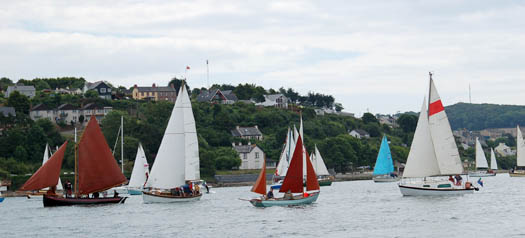
People sail boats of all types
Why is this?
Throughout my years of being a marine journalist and when marine correspondent within RTE, it was difficult to get coverage for sailing. I did achieve it, but there was always a bit of a battle to establish acceptance that the sport was not just for the wealthier part of the population, but that it permeated across all social milieu. I did get that message across by quoting figures of how many are actively involved in a day's racing organised by major clubs, compared with the attendance for example at some Irish soccer matches which got plenty of media coverage. I also stressed that it was a participative sport more than a spectator one. More people within the broadcast service have become involved in the sport. But generally in the media, there is still an impression that sailing is a sport for which you need a lot of money and this is perpetuated by the oft-quoted unfortunate analogy of standing under a cold shower and tearing up money.
But sailing – and yacht – clubs are also contributors to this failure to get the message of sailing as a sport for all across. In my experience as a journalist, most clubs are poor at their public relations and the issuing of information to the press, but yet complain that the sport does not get enough coverage, even if they do not provide the information. There are honourable exceptions, who provide good circulation of information and websites, but there are many other clubs who are pretty bad at sending information and whose websites are dismal failures, not updated for long periods of time.
At the annual meeting of the South Coast Offshore Racing Association in Kinsale Yacht Club in the Spring one participant told the audience that "yacht clubs to most people would be the scariest places to walk into."
Another said: "It is no wonder that we struggle as a sport to keep people as lifelong participants, even though we can and do attract younger people into the sport at an early age."
The warning signs have been there for years, for those who wanted to note them. Sailing needed to widen its appeal, to get more people into the sport for lifelong participation.
To survive a sport needs an organised structure and clubs are needed to provide this, they must have members who pay to join and support them. They cannot exist if people use them without joining and therefore not giving on-going financial and volunteer support.
So there is a dichotomy here. Why are clubs not getting enough members, a situation which appears widespread?
The economy over the past few years has undoubtedly been a contributory factor. People have lacked disposable income and, amongst families in particular, expenditure on non-essential matters has had to be cutback. Some clubs have responded with different arrangements for membership, but as I wrote in this blog last week, I still think that new, flexible approaches are needed, particularly to encourage crews, of which most active racing boats are short.
There are also people who sail and who do not join clubs, either they don't want to, or can't or there are not clubs close to them or for whatever reason. But they do sail, are they outside of the system and should they be considered. How can they be appealed to because they are involved in the sport. There are the traditional boats and the huge support they get. Some are members of the ISA, some of clubs, but many not so perhaps. There is a huge level of support for sailing in this sphere and many organised events which draw big support. Should the ISA reach out to these sailors, to this area of sailing activity?
This and many other aspects merit consideration to band together all interested in sailing, in all its facets. United in approach there would be a strong force which official authorities could not ignore when improved facilities and recognition are sought or when government and officialdom has to be challenged, such as in the imposition of new regulations.
On this month's edition of my radio programme, THIS ISLAND NATION, (click to play podcast above) I talked to the President of the Irish Sailing Association about his plan for a Strategic Review of the sport to deal with a decline and he accepted my suggestion that the impression of elitism is not good for the sport and has not helped its expansion and development. We also discussed whether there was too much concentration on racing and whether more support should be given to other forms of sailing, encouraging cruising.
David Lovegrove wants to get across the message that sailing is open to everyone. He would be particularly happy, he told me, if he could get that understood and accepted widely in public. We discussed how sailing can be a sport for all ages and for all people, with the uniqueness of enabling families to participate together if they wished. He recalled the time when he first got involved in sailing and the enjoyment and sense of friendship that abounded. Perhaps too, we agreed, there was less concentration then on being winners in racing and in high performance levels.
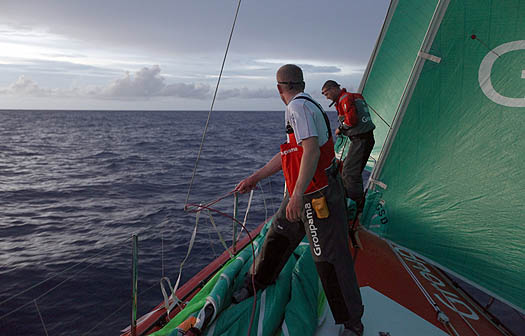
Ocean racer Damian Foxall of County Kerry
I think there is a need for Ireland to have a good presence on the international scene and that it is good for the country. It is also good for sailors to aspire to the highest levels of achievement, but have we got over-committed to competition to the detriment of the enjoyment of participation, of being on the water. Had the ISA also been too focussed on its own high performance programme and those who qualify for it and not given enough support to other sailors who may not have made it through the ISA system, but want to try on the international scene and should there be arrangements to support that. Also, for example, has the ISA been close enough to the top international sailors who have come from Ireland and sought to include them and utilise their services in promoting Irish sailing, such as Damian Foxall and Justin Slattery and where is the ISA in regard to the efforts of such as young David Kenefick making his own way onto the international scene through the Figaro Race.
All of these are interesting points to debate.
I take part in club racing, but I always try to make it clear to the crew that we are going out to enjoy ourselves and winning is not the overall aim, though it would be nice and we have been fortunate enough to do so from time-to-time. I don't like shouting on a boat, though sometimes getting something done quickly when needed can raise the vocal level. But if the enjoyment is taken out of the sport, that is not for the best.
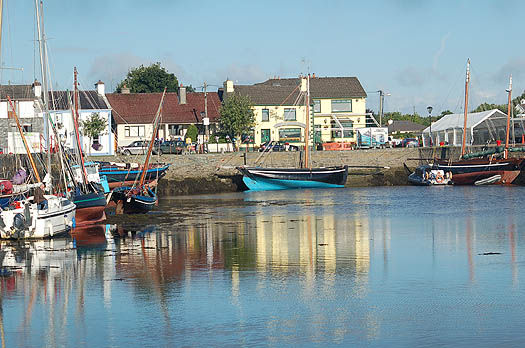
All forms of sailing need to be engaged
Again, here we have a dichotomy, other sports are hugely competitive-oriented, why should sailing not be?
There are issues to be addressed and I wish David Lovegrove and his team every success as they try to come up with answers. He told me in our interview, that this would not be a short-term solution, but would take a lot of work and commitment by the clubs themselves. Indeed. As I wrote in this blog last week, encouraging participation is essential to arrest decline. That will mean more innovative ways of involving people, a point which Denis Kiely, who has given tremendous national service to sailing made at that SCORA meeting in Kinsale and which impressed me.
He said that often crews did not get enough of a proper introduction to the sport, didn't have enough knowledge of it and weren't given such, didn't get training, could therefore feel unwelcome and then leave the sport.
Club marinas are pretty full of boats around the country, so it is at times hard to accept that there is a decline in participation, but the meetings which have led to the new approach by the ISA have shown problems, including dissatisfaction with the national association itself. David Lovegrove has accepted this and the need for change.
He spoke to me of his enthusiasm about the work ahead to re-define the sport and his confidence in the team he has appointed to oversee different aspects of the sport and to suggested changes. These are outlined in detail in the current/Summer edition of AFLOAT magazine.
His determination to create a strong, vibrant sport, is welcome. I wish him success with his efforts. Listen to his interview in my programme here on the Afloat website (above). Everyone interested in the future of our sport should respond positively. That commitment is what the sport needs.
So – who is to blame for the decline in sailing – all of us are, if we do not make changes to encourage more people into the sport and to stay in it and if we do not adapt existing systems to ensure they feel welcome. That means all of us who want to see sailing being a sport for all accepting that sailing is just that - a sport - not a badge of social approval.




























